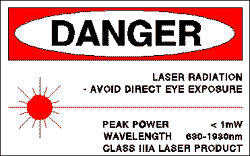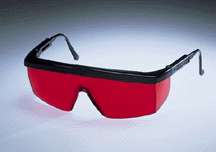Optical
Radiation: Laser Protection
 Laser
work and similar operations create intense
concentrations of heat, ultraviolet, infrared, and reflected light
radiation. A laser beam, of sufficient power, can produce
intensities
greater than those experienced when looking directly at the sun.
Unprotected
laser exposure may result in eye injuries including retinal burns, cataracts,
and permanent blindness. When lasers produce invisible ultraviolet,
or other radiation, both employees and visitors should
use appropriate eye protection at
all times. Laser
work and similar operations create intense
concentrations of heat, ultraviolet, infrared, and reflected light
radiation. A laser beam, of sufficient power, can produce
intensities
greater than those experienced when looking directly at the sun.
Unprotected
laser exposure may result in eye injuries including retinal burns, cataracts,
and permanent blindness. When lasers produce invisible ultraviolet,
or other radiation, both employees and visitors should
use appropriate eye protection at
all times.
Determine the maximum power density, or intensity, lasers produce when workers are exposed to
laser beams. Based on this knowledge, select lenses that protect against
the maximum intensity. The selection of laser protection
should depend upon the lasers in use and the operating conditions. Workers
with exposure to
laser beams must be furnished suitable laser protection.
[1926.102(b)(2)]
|
|
Lens Requirements |
Every pair of laser
safety spectacles or goggles must bear a label with the
following information:

Figure
1:
Laser Safety Lenses |
-
Windows are available
in both removable or lift-front designs:
-
Removable windows
allow the replacement of damaged windows.
-
Lift-front windows
may be raised, as needed, or left in the
lowered position.
|
 |
| Selecting
Laser Safety Glass |
The following table
shows the maximum power or energy density for
which adequate protection is afforded by
safety goggles of optical densities from 5
through 8. [1926.102(b)(2)(i)]
|
Intensity,
CW maximum power density [watts/cm(2)]
|
Attenuation
|
|
Optical
Density (O.D.)
|
Attenuation
Factor
|
10(-2)
10(-1)
1.0
10.0
|
5
6
7
8
|
10(5)
10(6)
10(7)
10(8)
|
When lasers emit
radiation between two measures of power
density (or light blocking capability) lenses
must be provided that offer protection against
the higher of the two intensities.
|
 |
|
|
